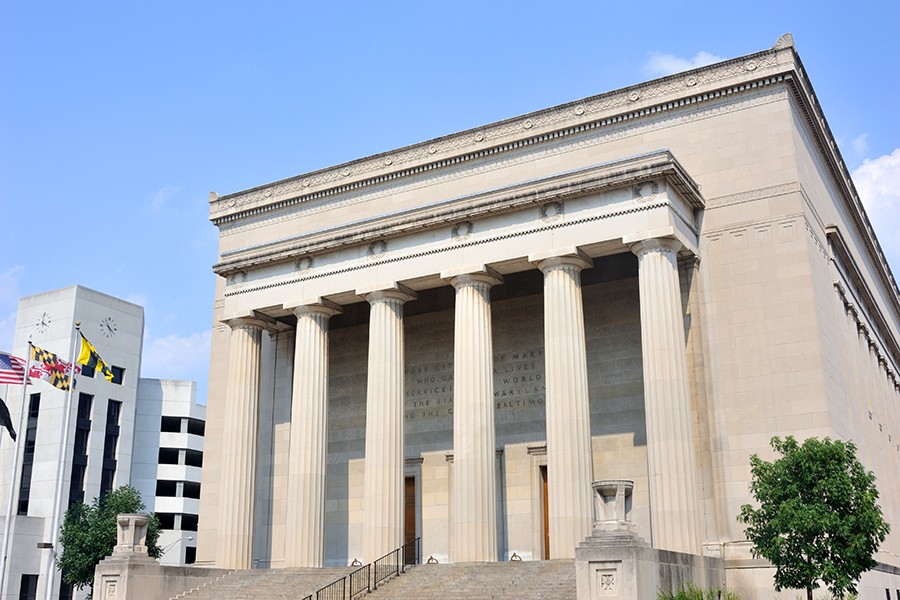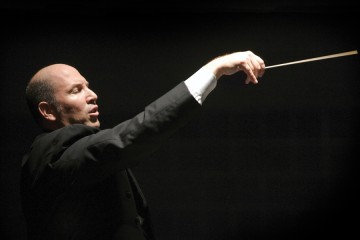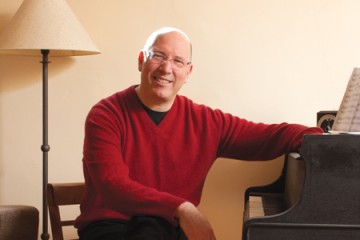When the full Hopkins Symphony Orchestra performs the debut concert of its 2017–18 season, it'll be doing so in a venue it hasn't visited in about 80 years.
Due to ongoing renovations at Shriver Hall, the Oct. 15 concert and the Dec. 2 performance with the JHU Choral Society and the Baltimore School for the Arts chorus will take place at the War Memorial, the stately hall in downtown Baltimore built by the city and state in 1925 to honor Maryland citizens who served in the First World War.
HSO music director Jed Gaylin says that he and his staff typically program their seasons about a year in advance, so this year's repertoire was already in place when, in mid-December, they found out Shriver was going to be closed beginning this fall. He and HSO general manager Nicoleen Willson set about looking for a suitable alternate site.
"We visited about 12 different venues in the Baltimore area," Gaylin says. "And it's harder than you think. Maybe the stage is great, but it holds 5,000 people. We wanted to be in the city. And the War Memorial hits all the markers we needed. And we've got some history with it."
Though the current iteration of the HSO, the city's only community orchestra, was started in 1981 by Peabody Institute graduate student Catherine Overhauser, an earlier incarnation of the Johns Hopkins Orchestra played at the War Memorial shortly after it was dedicated. According to articles in the archives of The Baltimore Sun, the Johns Hopkins Orchestra started in the late 1910s, and in a review of its third annual concert at Peabody in 1921, the review noted that "this organization of about 90 members consists to a large extent of amateurs, along with many other players who are just emerging from the student stage, the work done will appear as deserving of the warm praise."
Under the direction of Charles Bochau, a Peabody alum, and Bart Wirtz, a Peabody faculty member and one of the founding members of the Baltimore Symphony Orchestra in 1916, it performed annual benefit concerts for former Maryland servicemen and their families at the War Memorial beginning in 1926. Jackson Gilman-Forlini, the Historic Properties Program Coordinator for the City of Baltimore, notes that attendance records show that those concerts lasted through 1933. The Baltimore Sun notes that the 1927 concert included Bizet's "L'Arlesienne Suite" and Brahms' Hungarian Dance No. 5, composers that Gaylin's programming for this season serendipitously echoes, with Bizet's Symphony in C on Oct. 15 and Brahms' Tragic Overture & Variations on a Theme by Haydn in December.
The change in venue subtly tweaked the first two concert's reps and presented a new series of logistical hurdles—relocating rehearsals, more lead time to prep the venue for their performances and audiences, for example—but Gaylin adds, "there are opportunities to be taken advantage of when something like this comes about." The HSO reached out to Baltimore Heritage, a nonprofit historic and architectural preservation organization, to offer tours of the War Memorial prior to the concerts. And the HSO is offering 50 percent off ticket prices at the door to Baltimore City employees for both concerts as well.
"We're always trying to think of different ways of reaching out to the community," not only in the efforts to bring people into the audience, but also in the music the orchestra plays, Gaylin says. "If you're a sentient person who reads the newspaper and pays attention, these pieces speak to us today because they deal with human emotions, dilemmas, and vicissitudes so powerfully that if you're really investigating those pieces each time, they do speak freshly."
Sunday's concert features Alan Hovhaness' Prelude and Quadruple Fugue, Op. 128 and Jean Sibelius' Violin Concerto, featuring BSO concertmaster Jonathan Carney as soloist, in addition to the Bizet.
"There's a newness and freshness to [Symphony in C] that I find always in Bizet's music," Gaylin says. "There's just something about the sound that feels like a freshly picked piece of fruit. It doesn't feel like something written more than 100 years ago, and there's something very beautiful about that that we need to be reminded about today. And if we contrast that with the Hovhaness, which is very mysterious and brooding and has an edgy mysticism to it, I think that speaks to us today in a way that it wouldn't have five years ago—and the Sibelius even more so."
It's a concert program that Gaylin is very much looking forward to hearing the HSO realize.

Image caption: Jed Gaylin, music director of the Hopkins Symphony Orchestra, conducts both performances this fall
Image credit: COURTESY JED GAYLIN
"We had really great auditions this year and the group feels like it's gelling really early on, and that's a good feeling," Gaylin says. "I'm very excited about this year—I say that every year, but there's an energy to it. This is my 26th year and I'm just in love with it as much as ever. [When programming], a lot of the time I'm looking for variety in the year, a variety of backgrounds and styles, things that will push the orchestra in different ways, and things that will also allow them to shine."
This year, that includes temporarily moving the orchestra away from its usual home base.
"I've worked with many orchestras that are nomadic and it can have its challenges," Gaylin says. "But for a group that usually has a home, and you know the home is going to be upgraded, to go off and do something like this is very exciting."
Posted in Arts+Culture










